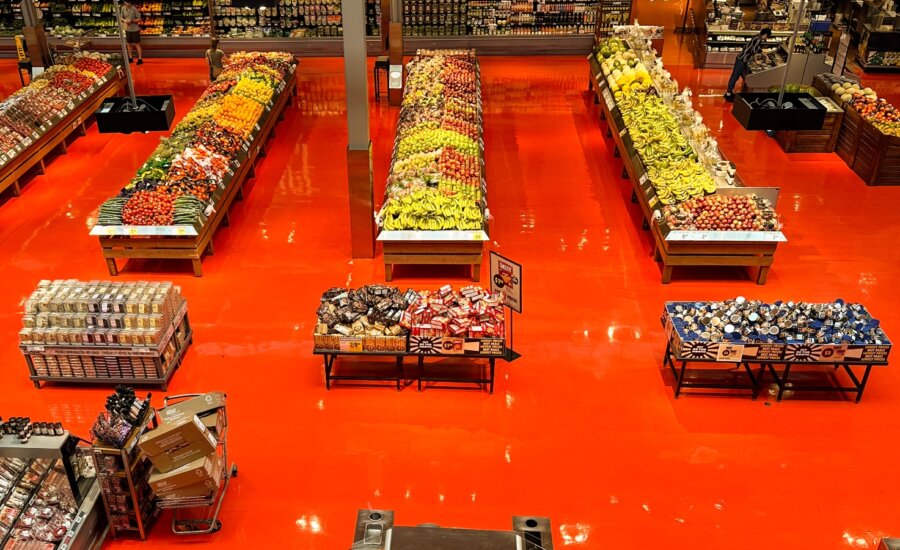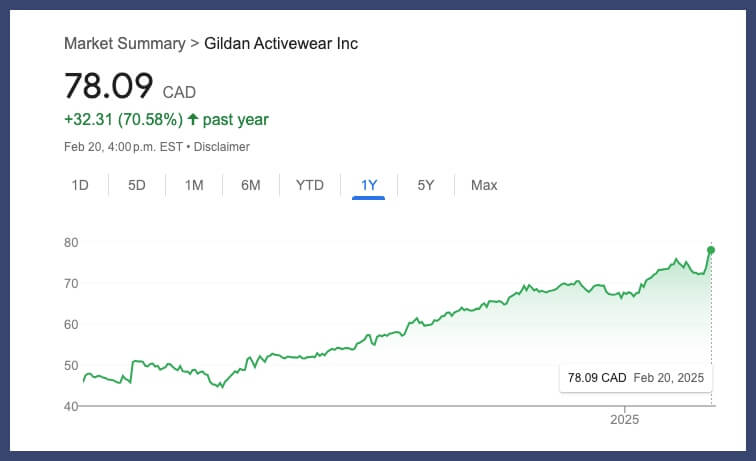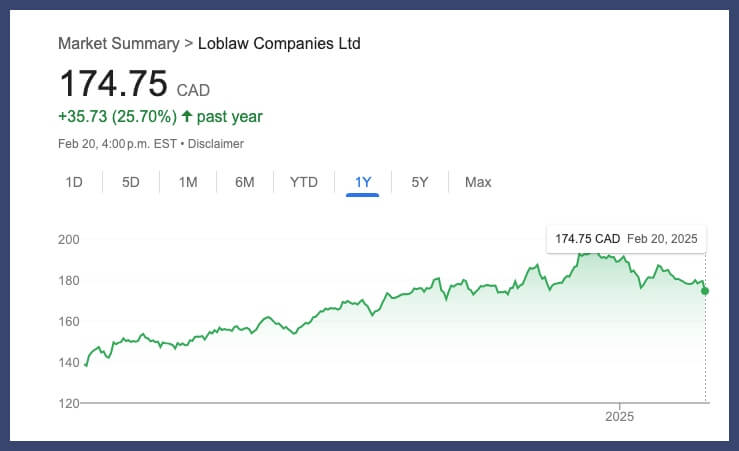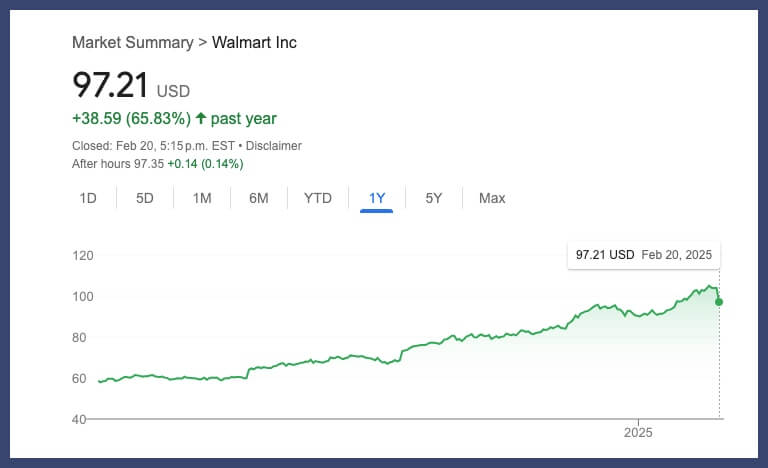Stock market news for Canadian investors: Loblaw, Walmart and more
Gildan Activewear also reported earnings this week. Here are the details for Canadian investors.
Advertisement
Gildan Activewear also reported earnings this week. Here are the details for Canadian investors.


(All figures in U.S. dollars.)
Gildan Activewear Inc. raised its dividend as it reported a fourth-quarter profit of $132.3 million. (All figures in U.S. dollars.)
The clothing maker said Wednesday it will pay a quarterly dividend of 22.6 cents per share, up from 20.5 cents.
The increased payment came as Gildan, which keeps its books in U.S. dollars, said it earned 86 cents per diluted share for the quarter ended Dec. 29 compared with a profit of $153.3 million or 89 cents per diluted share a year earlier.
Net sales for the quarter totalled $821.5 million, up from $782.7 million.
On an adjusted basis, Gildan says it earned 83 cents per diluted share in its latest quarter, up from an adjusted profit of 75 cents per diluted share a year earlier.
“By reinforcing our core competencies as a low-cost, large-scale, vertically integrated sustainable manufacturer, we continued to enhance our competitive advantage, and we are well positioned for continued growth in the years ahead,” Gildan chief executive Glenn Chamandy said in a statement.
In its outlook, the company said it expects revenue growth for 2025 to be up mid-single digits, while adjusted diluted earnings per share are expected to be in a range of $3.38 to $3.58, an increase of between 13% and 19%.
In addition to its financial results, Gildan announced Chuck Ward, currently president of sales, marketing and distribution, has been appointed to the new role of executive vice-president and chief operating officer effective March 1. The company also said Rhodri Harries, Gildan’s chief financial and administrative officer and executive vice-president, will retire on Jan. 1, 2026.
Luca Barile, currently CFO of sales, marketing and distribution, will succeed Harries as executive vice-president and chief financial officer on March 1. Harries will retain the chief administrator officer role until his retirement.

Loblaw Companies Ltd. is seeing more participation in its popular PC Optimum loyalty program—and more points being redeemed at checkout.
Customers redeemed more than a billion dollars’ worth of Optimum points in 2024, according to Loblaw’s annual report. There are more than 17 million active Optimum users.
The strength of the program caused the grocery retailer to take a non-cash charge of $129 million in its fourth quarter that drove profits lower year over year, as the company re-evaluated the program’s liability for outstanding Optimum points to reflect the higher use.
“We increased this liability based on our expectation that more customers will redeem more of their … points going forward,” said chief financial officer Richard Durfresne on a conference call discussing the results.
“What it reflects is that more and more consumers are liking PC Optimum, are using it, and so from our perspective … we’re more than happy to do it because it reflects what’s happening in our stores.”
The parent company of Loblaws and Shoppers Drug Mart says its net earnings available to common shareholders amounted to $462 million or $1.52 per diluted share for the quarter ended Dec. 28.
The result was down from a profit of $541 million or $1.72 per diluted share in the fourth quarter of 2023.
Amid a looming trade war with the U.S. that could see import tariffs on both sides of the border, Loblaw has been highlighting domestic products in its stores as shoppers look to buy Canadian. It also added a “swap and shop” feature to its loyalty app to help shoppers find Canadian products more easily.
The efforts appear to be paying off.
“As we continue to expand this feature, we are already seeing a significant uplift in sales (of) products identified as prepared in Canada,” said CEO Per Bank.
Loblaw is also monitoring how tariffs could affect prices on its U.S. products. If Trump brings in tariffs and Canada retaliates, it may have to pay more for items it brings in from south of the border, which would also put upward pressure on retail prices.
Less than 10% of the company’s supply comes from the U.S., said Bank, with most of it being produce. Canada is particularly reliant on produce imports in the winter.
“If tariffs are applied on produce, there’s where we will be mostly impacted,” said Bank.
The company has some plans to mitigate the effects of tariffs, but produce is the hardest thing to replace, said Bank, estimating Loblaw could mitigate the impact on about half of the U.S. produce the company buys.
“We are seeing these tariffs as a kind of tax on products that will hurt consumers on both sides,” he said.
But in other areas, the company is better positioned to offer consumers an alternative, Bank said. For example, Loblaw carriers household and cleaning products from more than 30 U.S. vendors but also has a strong array of products in that category among its private-label brands No Name and President’s Choice, he said.
“If the tariffs will be applied on household and cleaning, then of course, those products will not be competitive anymore, and all the sales will go to our control brands, and they’re all produced in Canada,” he said.
“So that’s good for Canada, it’s good for customers, and it’s good for us.”
The weakness of the Canadian dollar is adding further inflationary pressure at a time when Canada relies on the U.S. for fresh produce, added Dufresne.
“That is inflationary, and we’ve been starting to feel it quite seriously over the last few weeks.”
The loonie’s decline is also compounding the fact that Loblaw continues to see higher-than-normal price increase requests from large global suppliers, he said.
On Wednesday Loblaw announced it plans to spend $2.2 billion in 2025, opening 80 new grocery and pharmacy stores with about 50 of them being discount grocers. Bank says many will be smaller-format stores, building the company’s network of those types of grocers after launching small-format No Frills stores for the first time last May.
The investment, which is part of about $10 billion over five years, will also add 100 pharmacy care clinics to the company’s network.
The company is also planning to open the first phase of its new automated distribution centre in East Gwillimbury, Ont. The ramp-up starts with frozen products, said Bank.
Loblaw opened 52 new stores in 2024 as well as 78 new clinics.
On an adjusted basis, Loblaw says it earned $2.20 per diluted share in its latest quarter, up from an adjusted profit of $2 per diluted share a year earlier.
Revenue for the quarter totalled $14.9 billion, up from $14.5 billion, as food retail same-stores sales rose by 2.5%. Excluding the favourable impact of the timing of Thanksgiving, Loblaw says food retail same-store sales were up about 1.5%.
Consumers continue to favour discount stores over conventional stores, though the gap is stabilizing, said Dufresne.
Drug retail same-store sales rose 1.3%, with pharmacy and health care services same-store sales up 6.3%, offset in part by a 3.1% drop in front store same-store sales.
Loblaw shares fell 2.6% to $174.75 Thursday on the Toronto Stock Exchange.

(All figures in U.S. currency.)
Walmart delivered another year of strong sales and profits as its competitive prices became a strong magnet for inflation-weary shoppers. Yet uncertainty about the state of the American consumer and the potential impact of tariffs have seeped into expectations for 2025.
The financial outlook from the nation’s largest retailer, which has thrived amid stubborn inflation, delivered a jolt across the retail sector. Walmart sees per share profit over the next year coming in as much as 27 cents below analyst projections, a notable shift that sent company shares down more than 6% in midday trading. (All figures in U.S. dollars.)
Its sales outlook was also mild, potentially a reflection of challenges ahead as consumers pull back on spending and President Donald Trump’s tariffs on China and other countries threaten the low-price model that is the core of Walmart’s success.
During an interview with The Associated Press Thursday, Walmart’s Chief Financial Officer John David Rainey said shoppers remain resilient while cautious, but there is no apparent change in behavior related to tariffs.
There is more uncertainty about what lies ahead and Rainey said Walmart’s measured guidance reflects that.
“We are one month into the year, and there’s a lot that we don’t know,” Rainey said, citing the new tariff increases.
Walmart did not incorporate tariffs into its financial outlook, but Rainey acknowledged that the company isn’t immune to their impact.
“We’re going to work really hard to keep prices low for our members and customers,” Rainey said. “We will do the things that we can.”
That means being nimble with sourcing. Walmart, for example, is exploring new sourcing for microwave ovens given increased tariffs on aluminum and steel. But Rainey said some goods may have price increases.
Tariffs in the headlines have fueled concern and some more shopper retrenchment in Walmart’s Mexico business, Rainey said.
Walmart has built in hedges against some tariff threats. Two-thirds of Walmart’s merchandise is sourced in the U.S., with groceries driving much of that. Groceries account for roughly 60% of Walmart’s U.S. business.
Still, Walmart shares took a hit, and other big retailers fell, too.
Walmart is among the first major U.S. retailers to report financial results and the numbers can provide a hint as to the mood of the American shopper. Over the past year Americans have focused increasingly on necessities rather than big TVs, furniture or appliances. They’ve become much more discerning because of higher costs for credit as well as for groceries.
Walmart has flourished in that environment. It’s gained market share, notably among households with incomes over $100,000. Walmart’s online offerings and paid membership, Walmart +, have also drawn wealthier customers
“We have momentum driven by our low prices, a growing assortment, and an eCommerce business driven by faster delivery times,” said CEO Doug McMillon. “We’re gaining market share, our top line is healthy, and we’re in great shape with inventory.”
Still, Walmart could be faced with challenges with the new tariffs carrying more economic risks than during Trump’s first term. If Americans are hit by a new wave of price increases, economists say, and with 70% of the U.S. economy driven by consumers a broad pullback in spending would have ramifications beyond Walmart’s sales.
Government data last week revealed a sharp drop in January retail sales as cold weather kept more Americans indoors. But it was a much bigger drop than economists expected and the biggest in a year.
Walmart, based in Bentonville, Arkansas, reported earnings of $5.25 billion, or 65 cents per share, in the quarter ended Jan. 31. That compares with $5.49 billion, or 68 cents per share, in the year-ago period. Adjusted earnings per share for the most recent quarter was 66 cents. Sales rose 4.1% to $180.55 billion in the quarter.
Analysts expected 65 cents per share on sales of $180.07 billion, according to FactSet.
For Walmart’s U.S. division, comparable store sales — which include online and stores open for the past 12 months — rose 4.6% in the U.S., a bit lower than the 5.3% in the previous quarter. The retailer had a 4.2% jump in the U.S. in the second quarter and 3.8% in the first quarter.
Global e-commerce sales rose 16% in the latest quarter, notably slower than the 27% increase in the third quarter.
Walmart expects first quarter earnings per share of between 57 cents and 58 cents, well below the 64 cents Wall Street was expecting, and for the year. Walmart projects earnings per share in the range of $2.50 to $2.60. That’s also off the $2.77 that analysts are predicting, according to FactSet.
It forecast a 3% to 4% increase in quarterly sales or between $166.35 billion and $167.97 billion. That is also a bit light, with analysts expecting sales of $167.05 billion.
Walmart expects annual sales to rise between 3% and 4%, or between $667.57 billion and $674.05 billion. That too falls short of the $708.72 billion that Wall Street projected.
Share this article Share on Facebook Share on Twitter Share on Linkedin Share on Reddit Share on Email
I found the recent earnings report from Walmart interesting, especially in relation to the stock market trends. It’s great to see how retail giants are adapting!